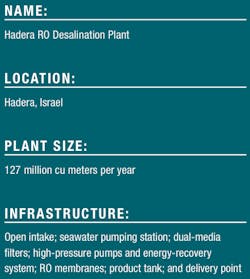Caitlin Cunningham is managing editor of Water & Wastes Digest. Cunningham can be reached at [email protected] or 847.391.1025.
Israel is in the midst of a water crisis. The past six years have marked one of the Middle Eastern nation’s most severe drought periods, while population and commercial growth continue to drive increased water demands. Today the country is using almost double the amount of water it has available: about 2 billion cu meters per year consumed vs. approximately 1.3 billion cu meters per year of natural replenishment. To meet its pressing water supply needs, Israel has turned not only to water reuse but also desalination.
“In 2000, the Israeli government agency Water Desalination Administration launched the Desalination Master Plan, comprising large-scale seawater plants along the Mediterranean and envisaging a total volume of approximately 650 million cu meters per year by the year 2020,” said Fredi Lokiec, executive vice president of special projects for IDE Technologies Ltd.
Three desalination facilities—the Ashkelon (2005 startup), Palmachim (2007) and Hadera (2009) plants—currently operate in Israel, and two more facilities—the Ashdod (expected 2012 startup) and Sorek (2013) plants—are underway. The existing operations supply about 40% of Israeli domestic water consumption. By 2013, with five plants in operation, the government intends to meet 70% of the domestic need with desalinated water.
"The Desalination Master Plan in Israel is being implemented as planned, and in this regard, excluding Saudi Arabia and the Gulf countries, Israel is—together with Australia, Singapore and Spain—among the countries that successfully implement seawater desalination at a large scale as a reliable and available source of water supply,” Lokiec said.
Facility Walk-Through
The Hadera seawater reverse osmosis (RO) desalination plant is the largest operation of its kind globally. The plant originally was designed to produce 100 million cu meters of water per year. In 2009, however, the project team signed an addendum to increase capacity to a state-mandated 127 million cu meters per year. The expansion work was completed in 2010.
The 1,300-meter-long, 50- to 150-meter-wide facility, divided into equally sized eastern and western buildings, is located on the site of the Orot Rabin Power Station in the city of Hadera, Israel, north of Tel Aviv. The plant’s unusually narrow layout was designed to accommodate limited land availability, preserve valuable coastal space and streamline the permitting process.
Water from the neighboring Mediterranean Sea enters the Hadera facility through an open intake. It travels to a pumping station, from which it is sent through dual-media cartridge (micronic) filters. Once the water has undergone pretreatment, high-pressure pumps bring it to RO membranes for additional filtration. A re-hardening treatment follows, in which the membranes’ permeate flows to a dedicated post-treatment in which calcium (hardness) is added to the product water. Finished water is conveyed either to an onsite product tank for temporary storage or directly to the public supply delivery point.
Backwash water from the dual media and re-hardening filtration, as well as brine water from the RO process, is treated separately and delivered back to the sea.
Dollars & Sense
IDE Technologies and a consortium of international financial institutions funded the $425-million (USD) Hadera RO Desalination Plant build-operate-transfer undertaking. Never before had foreign banks financed such a large-scale project in Israel, and Euromoney Project Finance recognized this accomplishment with a 2007 Deal of the Year award.
The Hadera facility is a standout in terms of its treatment costs as well. The operation is producing high-quality potable water—personally taste tested by the author—from Mediterranean seawater for approximately 60 cents (USD) per cubic meter, among the lowest desalination costs worldwide. Care is taken to maximize production during off-peak hours in order to avoid the highest electricity fees, and the plant employs an energy-recovery system with its high-pressure pumps: key factors in controlling operational expenditure costs and keeping treatment costs affordable.
In 2032, marking 25 years after the notice to proceed was issued, ownership of the Hadera RO Desalination Plant will be transferred to the Israeli government.
Editor’s note: For more notes and photos from the author’s Water and Energy Environmental USA Press Tour in Israel, visit the Blogs section on www.wwdmag.com or Water & Wastes Digest’s social media pages (LinkedIn, Facebook and Twitter).
Download: Here


